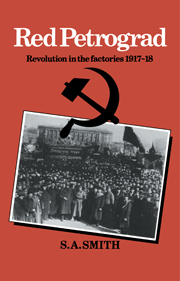Book contents
- Frontmatter
- Contents
- Acknowledgements
- Introduction
- 1 A profile of the Petrograd working class on the eve of 1917
- 2 The tsarist factory
- 3 The February Revolution: A new dispensation in the factories
- 4 The structure and functions of the factory committees
- 5 Trade unions and the betterment of wages
- 6 The theory and practice of workers' control of production
- 7 Deepening economic chaos and the intensification of workers' control
- 8 The social structure of the labour movement
- 9 The October Revolution and the organisation of industry
- 10 The economic crisis and the fate of workers' control: October 1917 to June 1918
- Conclusion
- Notes
- Bibliography
- Index
1 - A profile of the Petrograd working class on the eve of 1917
Published online by Cambridge University Press: 11 January 2010
- Frontmatter
- Contents
- Acknowledgements
- Introduction
- 1 A profile of the Petrograd working class on the eve of 1917
- 2 The tsarist factory
- 3 The February Revolution: A new dispensation in the factories
- 4 The structure and functions of the factory committees
- 5 Trade unions and the betterment of wages
- 6 The theory and practice of workers' control of production
- 7 Deepening economic chaos and the intensification of workers' control
- 8 The social structure of the labour movement
- 9 The October Revolution and the organisation of industry
- 10 The economic crisis and the fate of workers' control: October 1917 to June 1918
- Conclusion
- Notes
- Bibliography
- Index
Summary
PETROGRAD: THE CITY AND ITS INDUSTRY
Petrograd was a city of sharp contrasts. It was the capital of the Russian Empire, yet closer culturally to Western Europe than to the rest of Russia. It was at once a city of elegant grandeur, lauded by Pushkin, and a city of eerie squalor, abhorred by Dostoevsky. Petrograd was both symbol of tsarist power and of popular revolt. Here the Imperial Court headed an army of 70,000 civil servants; here in 1905 the first Soviet had headed a general strike. Along the avenues and canals of the city centre stood palaces, splendid emporia, banks and company offices. Across the river stood bleak tenements and teeming factories. Not a stone's throw from the University and the Academy of Sciences thousands of people lived in appalling ignorance and misery. Petrograd was home to rich and poor, to a thriving revolutionary underground and to the Holy Synod, to the liberal opposition and to the Black Hundreds. Here in February 1917 a revolution erupted which was to have world-shattering reverberations.
In 1917 Petrograd had a population of 2.4 million, making it the fifth largest city in Europe. The Russian Empire had about 182 million inhabitants, less than a fifth of whom lived in towns. Petrograd was by far the largest city in the Empire; between 1897 and 1914 its population had grown from 1.26 million to 2.21 million – a very high rate of growth, compared to the average for the country as a whole. This growth was largely due to the immigration of peasants from the countryside.
- Type
- Chapter
- Information
- Red PetrogradRevolution in the Factories, 1917–1918, pp. 5 - 36Publisher: Cambridge University PressPrint publication year: 1983



